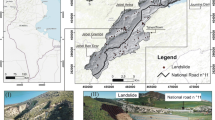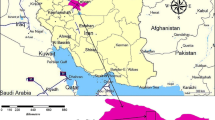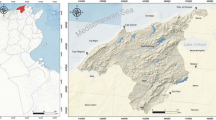Abstract
Landslides cause extensive loss of life and property in the Nepal Himalaya. Since the late 1980s, different mathematical models have been developed and applied for landslide susceptibility mapping and hazard assessment in Nepal. The main goal of this paper is to apply fuzzy logic to landslide susceptibility mapping in the Ghurmi-Dhad Khola area, Eastern Nepal. Seven causative factors are considered: slope angle, slope aspect, distance from drainage, land use, geology, distance from faults and folds, soil and rock type. Likelihood ratios are obtained for each class of causative factors by comparison with past landslide occurrences. The ratios are normalized between zero and one to obtain fuzzy membership values. Further, different fuzzy operators are applied to generate landslide susceptibility maps. Comparison with the landslide inventory map reveals that the fuzzy gamma operator with a γ-value of 0.60 yields the best prediction accuracy. Consequently, this operator is used to produce the final landslide susceptibility zonation map.
Similar content being viewed by others
References
Acharya, G., De Smedt, F. and Long, N. T. (2006) Assessing landslide hazard in GIS: a case study from Rasuwa, Nepal. Bull. Engg. Geol. Environ., v.65(1), pp.99–107.
Acharya, K.K. (2008) Qualitative kinematic investigations related to the extrusion of the Higher Himalayan Crystalline and equivalent tectonometamorphic wedges in the central Nepal Himalaya. PhD thesis, Universitat Wien, Austria.
Aleotti, P. and Chowdhury, R. (1999) Landslide hazard assessment: summary review and new perspectives. Bull. Engg. Geol. Environ., v.58(1), pp.21–44.
An, P., Moon, W.M. and Rencz, A. (1991) Application of fuzzy set theory to integrated mineral exploration. Canadian Jour. Explor. Geophys., v.27(1), pp.1–11.
Bonham-carter, G.F. (1994) Geographic information systems for geoscientists, modelling with GIS. Pergamon, Oxford, 398p.
Champati Ray, P.K., Dimri, S., Lakhera, R.C. and Sati, S. (2007) Fuzzy-based method for landslide hazard assessment in active seismic zone of Himalaya. Landslides, v.4, pp.101–111.
Bijukchhen, S.M., Kayastha, P. and Dhital, M.R. (2012) A comparative evaluation of heuristic and bivariate statistical modelling for landslide susceptibility mappings in Ghurmi-Dhad Khola, east Nepal. Arab Jour. Geosci. (doi: 10.1007/ s12517-012-0569-7)
Chung, C.F. and Fabbri, A.G. (1999) Probabilistic prediction models for landslide hazard mapping. Photogrammetric Engg. Remote Sensing, v.65(12), pp.1389–1399.
Dahal, R.K., Hasegawa, S., Nonomura, A., Yamanaka, M., Dhakal, S. and Paudyal, P. (2008) Predictive modelling of rainfall-induced landslide hazard in the Lesser Himalaya of Nepal based on weights-of-evidence. Geomorphology, v.102, pp.496–510.
Deoja, B.B., Dhital, M. R., Thapa, B. and Wagner, A. (1991) Mountain risk engineering handbook. International Centre for Integrated Mountain Development (ICIMOD), Kathmandu, Nepal, 875p.
Dhakal, A. S., Amada, T. and Aniya, M. (1999) Landslide hazard mapping and the application of GIS in the Kulekhani watershed Nepal. Mountain Research and Development, v.19(1), pp.3–16.
Dhital, M.R. (2005a) Landslide investigation and mitigation in Himalayas: focus on Nepal. Proc. International Symposium “Landslide Hazard in Orogenic Zone from the Himalaya to Island Arc in Asia”, Kathmandu, Nepal, pp.1–15.
Dhital, M.R. (2005b) Study of damage caused by rainfall in Hilepani-Jayaramghat-Diktel environment friendly road. Report submitted to the Rural Access Programme (RAP), Kathmandu, Nepal.
Dubey, C.S., Chaudhry, M., Sharma, B.K., Pandey, A.C. and Singh, B. (2005) Visualization of 3-D digital elevation model for landslide assessment and prediction in mountainous terrain: A case study of Chandmari landslide, Sikkim, eastern Himalayas. Geosciences Jour., v.9(4), pp.363–373.
Ercanoglu, M. and Gokceoglu, C. (2002) Assessment of landslide susceptibility for a landslide-prone area (north of Yenice, NW Turkye) by fuzzy approach. Environ. Geol., v.41, pp.720–730.
Ercanoglu, M. and Gokceoglu, C. (2004) Use of fuzzy relations to produce landslide susceptibility map of a landslide prone area (West Black Sea Region, Turkey). Engg. Geol., v.75, pp.229–250.
Ghimire, M. (2011) Landslide occurrence and its relation with terrain factors in the Siwalik Hills, Nepal: case study of susceptibility assessment in three basins. Natural Hazards, v.56, pp.299–320.
Goscombe, B., Gray, D. and Hand, M. (2006) Crustal architecture of the Himalayan metamorphic front in eastern Nepal. Gondwana Res., v.10, pp.232–255.
Gupta, R.P., Kanungo, D.P., Arora, M.K. and Sarkar, S. (2008) Approaches for comparative evaluation of raster Gis-based landslide susceptibility zonation maps. International Jour. Appld. Earth Observation and Geoinformation, v.10, pp.330–341.
Guzzetti F., Carrara, A., Cardinali, M. and Reichenbach, P. (1999) Landslide hazard evaluation: a review of current techniques and their application in a multi-scale study, Central Italy. Geomorphology, v.31, pp.181–216.
Gyawali, B. and Bijukchhen, S.M. (2011) Geological map of the Ghurmi-Dhad Khola area, Eastern Nepal (Scale 1:25,000). Central Department of Geology, Tribhuvan University, Kathmandu, Nepal.
Ishida, T. and Ohta, Y. (1973) Ramechhap-Okhaldunga region. In: S. Hashimoto, Y. Ohta, and C. Akiba, C. (Eds.), Geology of the Nepal Himalayas. Saikon, Sapporo (Japan), pp.35–68.
Joshi, J., Majtan, S., Morita, K. and Omura, H. (2000) Landslide hazard mapping in the Nallu Khola watershed, Central Nepal. Jour. Nepal Geol. Soc., v.21, pp.21–28.
Kanungo, D. P., Arora, M. K., Gupta, R.P. and Sarkar, S. (2008) Landslide risk assessment using concepts of danger pixels and fuzzy set theory in Darjeeling Himalayas. Landslides, v.5, pp.407–416.
Kanungo, D.P., Arora, M.K., Sarkar, S. and Gupta, R.P. (2006) A comparative study of conventional, ANN black box, fuzzy and combined neural and fuzzy weighting procedures for landslide susceptibility zonation in Darjeeling Himalayas. Engg. Geol., v.85, pp.347–366.
Kanungo, D.P., Arora, M.K., Sarkar, S. and Gupta, R.P. (2009) A fuzzy set based approach for integration of thematic maps for landslide susceptibility zonation. Georisk: Assessment and Management of Risk for Engineered Systems and Geohazards, v.3(1): pp.30–43.
Kayastha, P. and de Smedt, F. (2009) Regional slope instability zonation using GIS technique in Dhading, Central Nepal. In: J.P. Malet, A. Remaître and T. Boggard. (Eds.), Landslide Processes: From Geomorphologic Mapping to Dynamic Modelling, CERG, France, pp.303–309.
Kayastha, P., De Smedt, F. and Dhital, M.R. (2010) GIS based landslide susceptibility assessment in Nepal Himalaya: a comparison of heuristic and statistical bivariate analysis. In: J.P. Malet, T. Glade and N. Casagli (Eds.), Mountain Risks: Bringing Science to Society, CERG Editions, France, pp.121–128.
Kayastha, P., Dhital, M.R. and De Smedt, F. (2012) Landslide susceptibility mapping using the weight of evidence method in the Tinau watershed, Nepal. Natural Hazards (doi: 10.1007/s11069-012-0163-z)
Lee, S. (2007) Application and verification of fuzzy algebraic operators to landslide susceptibility mapping. Environ. Geol., v.52, pp.615–623.
Lee S., Song, K-Y., Oh H-J. and Choi, J. (2012) Detection of landslides using web-based aerial photographs and landslide susceptibility mapping using geospatial analysis. International Jour. Remote Sensing, v.33(16), pp.4937–4966.
Long, N.T. (2008) Landslide susceptibility mapping of the mountainous area in A Luoi District, Thua Thein Hue Province, Vietnam. PhD thesis in Engineering, Vrije Universiteit Brussel, Belgium. 229 pp.
Nadim, F., Kjekstad, O., Domaas, U., Rafat, R. and Peduzzi, P. (2006) Global Landslides Risk Case Study. In: M. Arnold, R.S. Chen, U. Deichmann, M. Dilley, A.L. Lerner-Lam, R.E. Pullen, and Z. Trohanis (Eds.), Natural Disaster Hotspots, Case Studies. Disaster Risk Management Series No. 6. The World Bank, Hazard Management Unit, Washington DC, USA, pp.21–77.
Pantha, B. R., Yatabe, R. and Bhandary, N.P. (2010) GIS-based highway maintenance prioritization model: an integrated approach for highway maintenance in Nepal mountains. Jour. Transport Geography, v.18, pp.426–433.
Poudyal, C. P., Chang, C., Oh, H. and Lee, S. (2010) Landslide susceptibility maps comparing frequency ratio and artificial neural networks: a case study from the Nepal Himalaya. Environ. Earth Sci, v.61, pp.1049–1064.
Pradhan, B., Lee, S. and Buchroithner, M. F. (2009) Use of geospatial data and fuzzy algebraic operators to landslidehazard mapping. Applied Geomatics, v.1, pp.3–15.
Ray, R.L. and De Smedt, F. (2009) Slope stability analysis on a regional scale using GIS: a case study from Dhading, Nepal. Environ. Geol., v.57, pp.1603–1611.
Regmi, N.R. Giardino, J.R. and Vitek, J.D. (2010) Assessing susceptibility to landslides: Using models to understand observed changes in slopes. Geomorphology, v.122, pp.25–38.
Sarkar, S. and Kanungo, D.P. (2004) An integrated approach for landslide susceptibility mapping using remote sensing and GIS. Photogrammetric Engineering and Remote Sensing, v.70(5), pp.617–625.
Sharma, R.H. and Shakya, N.M. (2008) Rain induced shallow landslide hazard assessment for ungauged catchments. Hydrogeology Jour., v.16, pp.871–877.
Tangestani, M.H. (2004) Landslide susceptibility mapping using the fuzzy gamma approach in a GIS, Kakan catchment area, southwest Iran. Australian Jour. Earth Sci., v.51(3), pp.439–450.
Singh, R.P., Dubey, C.S., Singh, S.K., Shukla, D.P., Mishra, B.K., Tajbakhsh, M., Ningthoujam, P.S., Sharma, M. and Singh, N. (2012) A new slope mass rating in mountainous terrain, Jammu and Kashmir Himalayas: application of geophysical technique in slope stability studies. Landslides. (doi: 10.1007/ s10346-012-0323-y)
Thapa, P.B. and Dhital, M.R. (2000) Landslide and debris flows of 19–21 July 1993 in the Agra Khola watershed of central Nepal. Jour. Nepal Geol. Soc., v.21, pp.5–20.
Upreti, B.N. and Dhital, M.R. (1996) Landslide studies and management in Nepal. International Centre for Integrated Mountain Development (ICIMOD), Kathmandu, Nepal, 87p.
van Westen, C.J., Rengers, N. and Soeters, R. (2003) Use of geomorphological information in indirect landslide susceptibility assessment. Natural Hazards, v.30, pp.399–419.
Zadeh, L.A. (1965) Fuzzy sets. Information and Control. v.8, pp.338–353.
Zimmerman, H.J. (1996) Fuzzy set theory and it applications. Kluwer Academic Publishers, Norwell MA, USA. 435p.
Author information
Authors and Affiliations
Corresponding author
Rights and permissions
About this article
Cite this article
Kayastha, P., Bijukchhen, S.M., Dhital, M.R. et al. GIS based landslide susceptibility mapping using a fuzzy logic approach: A case study from Ghurmi-Dhad Khola area, Eastern Nepal. J Geol Soc India 82, 249–261 (2013). https://doi.org/10.1007/s12594-013-0147-y
Received:
Accepted:
Published:
Issue Date:
DOI: https://doi.org/10.1007/s12594-013-0147-y




